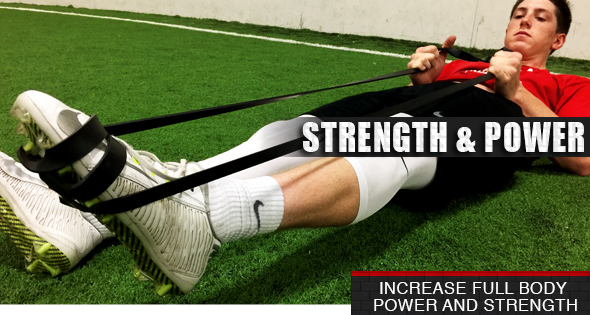How Do I Recover From a Sprained Ankle
There are two main types of ankle sprains - the traditional sprain of the lateral ligament which helps maintain the stability of the tarsal bones of the ankle, and the high ankle sprain to the ligaments which marry the tibia and fibula together making up the structure which the foot articulates within. While both sprains tend to be caused by an external force (such as an impact from another player, or by a planted foot which receives too much force from our own body in a direction the joint cannot accomplish) they can also both be treated with similar exercises.
Ballistic Ankle Rehab
In the above video there is a high focus in strength through the entire range of motion. This is important with regards to sprains because it is usually the weakest part of our range of motion that puts us in the most danger for injury. By using the Kbands Ballistic Bands to resist the ankle movements, the smaller accessory muscles and ligaments are forced to participate. This provides the opportunity for those weak parts in the range of motion to be exposed and strengthened.
In the Ballistic Ankle Rehab exercise you will be doing each motion 10-15 times or if you rather as a timed set of 30 seconds, pulling up on the band to increase resistance as needed. Whether the sprain is high ankle or traditional this exercise will create a burn in the accessory muscles and strengthen the structures of the ankle both helping an injured ankle to recover and also helping to avoid future injuries.
To further this exercise even more, turn the band around. Instead of the slack coming up towards your chest point it down off the foot and anchor it around something and work your shins as well. By strengthening both sides of ankle the integrity becomes more robust and further injury less likely.
Strength vs Bracing
Much of traditional thinking would have athletes with ankle injuries buy an ankle brace and protect the joint externally. However, that does not solve the issue. Imagine trying to do a pull-up and somehow injuring the bicep, then during recovery you put the arm in a cast to restrict movement so as to allow the tissues to rest and rebuild. After the allotted recovery time you decide you still want to do pull-ups, however you are asked to put the cast back on any time you decide to do that motion. A couple of things would happen in this scenario. One, your other arm would get really strong since it would be doing all the work - not intended, but interesting side result. Two, your previously injured arm would be harder to injure, but three - and in this instance most importantly - your previously injured arm would never get stronger, and you would never accomplish that pull up the same again. This is what bracing can do. While this is an oversimplification of common treatments it is meant to prove a point. Relying on ankle braces alone will rob your body of the opportunity to adapt and strengthen.
The body has a tremendous capacity to heal and recover, and while it is true the ligaments that are injured in an ankle sprain tend to loosen as a result, our traditional approach to recovery for these injuries does not give the body the opportunity to tighten and strengthen. Instead of relying solely on ankle braces and tape externally it is important to proactively strengthen the joint and thereby resist future injuries internally as well. Using the Ballistic Ankle Rehab routine, which focuses on strength through the entire range of motion the ankle will become more robust and stable, thereby making it more difficult for the ankle to accidentally move into a compromising position.
Injury Recovery
This exercise is merely part of a much larger recovery process. Particularly with high ankle sprains and traditional ankle sprains, it is important to immobilize for a time and to rest the joint. However as soon as possible it will be time to strengthen and rebuild range of motion. Sleep and nutrition are the other legs of recovery which are often overlooked. Go to the link for more information on those topics in particular, and for recovery in general check out the recovery section of kbandstraining.com. No matter the injury or strain you’ll find good exercises and advice that will have you back on the field or court in no time.

